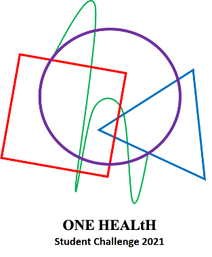 This past Thursday marked the end of the 2021 One HEALtH Student Challenge! This year’s Challenge was held fully online over the last 6 weeks with a record number of students taking part. The Launch Event was held in late January, at which students were introduced to the One Health approach with a focus on specific hardships that were amplified by the COVID-19 pandemic. Students this year got the chance to form their own multi-disciplinary teams, and came from a wide range of disciplines, including Neuroscience, Health Sciences, Architecture, Engineering, Computer Science, and Mathematics! Each team was supported by a pair of graduate mentors with diverse expertise. Their challenge was to consider the issues of systemic neglect, social isolation, and loneliness among older adults in Canadian society in light of the pandemic. The goal was to design an intervention (an application, program, tool, product, or strategy) that brings together young and older adults in a manner that is beneficial, sustainable, and appropriate under the restrictions put in place to minimize the spread of viruses such as COVID. 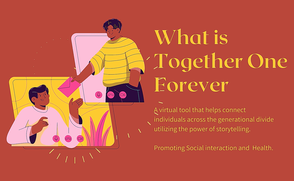 In the first few weeks of the One Health Challenge guest speaker presentations were held and lively conversations took place between students and non-profit and social enterprise leaders, as well as fellow students who took participated in programs aimed at fostering cross-generational connections. Soon after receiving input from the speakers and mentors, the students were well on their way to narrowing their scope and developing an intervention that would consider diverse perspectives and out-of-the-box thinking! A few short weeks later, the teams came together on March 18th for the final event. Their creative video pitches were featured for our judging panel. The students’ solutions showcased a wide variety of approaches to promoting cross-generational connections, touching on issues including food, storytelling, recreation, education, new technology, and design. Click here to see all of the teams’ video pitches! After intense deliberation and a Q&A with each of the teams, the judges decided on a winner: Together One Forever, created by students Kareena Ajith, Andreanne Morera Tanguay, Natasha Nayar, Sophia Rivas, and Matthew Wilson (mentored by Sam Petrie and Aisha Robinson). Their web-based program would pair seniors (65+) with youth (18-30) to create a virtual workbook about the older adult's life and experiences, developed collaboratively through interactive storytelling sessions. 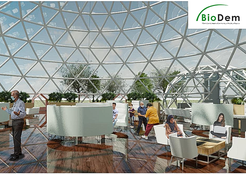 The judging panel also identified a runner-up: BioDem, created by students Neha Khanna, Izzy Munevar-Pelton, Hailey McGuire, Jaimie Reynolds, and Molly Zhang (mentored by Derek Mikola and Noa Gang). This solution combined innovative architecture with community programming to create an accessible, COVID-friendly space for cross-generational interaction. Each of the members of the winning teams received a $100 cash prize and will be presenting their work at Carleton University’s Life Sciences Day 4.1 on April 6th 2021! The judges were enthusiastic about the quality of the solutions, and several expressed interest in partnering with the student teams to pursue their ideas further. We are incredibly proud of the exemplary work and dedication from the students and mentors who helped make this year’s One HEALtH Challenge our most successful one yet!
0 Comments
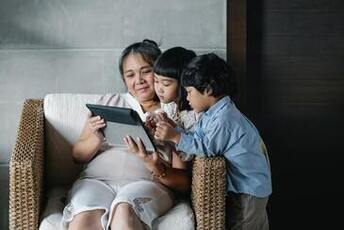 After 6 weeks of hard work by our student teams, the 2021 One HEALtH Challenge is almost at an end. We will be hosting the final event (held via Zoom) this Thursday, March 18th from 5:30 to 7:30 PM via zoom. After screening everyone's video pitches, each team will answer questions from our expert judges panel to help them decide on the winning team. The winners will receive $100 each and have their solution for promoting cross-generational connections featured on our website. We are so excited to share the solutions developed by this year's brilliant batch of interdisciplinary competitors. All are welcome! If you are interested in attending, please email us at [email protected].  Learn more about stress and mental health among students Learn more about stress and mental health among students By Candice Harris, Neuroscience and Mental Health Student At the beginning of 2020, I’d hit rock-bottom. I’d spent the previous year facing some of the biggest challenges of my life, and I finally caved under the pressure. Following an incident at the end of 2018, I was battling anxiety, panic attacks, depression, and delusions – all symptoms of PTSD that would land me at the hospital emergency twice. I’d developed a drug addiction as well as an eating disorder, and I was barely passing the few school courses I hadn’t withdrawn from. With my mental health at an all-time low, I knew I needed to seek help. This marked the beginning of my journey toward becoming a healthier, happier, and kinder human being. I threw my old mindset out the window and adopted a beginner’s mind: I started talking to friends and family, and I came clean to my doctors. I joined a program for cognitive behavioural therapy, borrowed books from the library on the neuroscience of mental health, and signed up for a meditation retreat. I met with an academic advisor and joined study groups for my courses. I started prepping healthy meals and I created a workout plan that included everything from yoga to circuit training. I began to journal about my emotions and about what I was most grateful for. Over the next few months, my mental health started to recover. I was at a point where I really wanted to help others and try to have a more positive impact on the world. The lockdown in March made this extremely difficult: I spent my extra time picking up litter around the community and educating myself on social causes, but I was itching to do more. My sister, knowing this, sent me a TikTok video which featured a young woman excitedly reciting the experience of her very first call from ‘Be My Eyes’. 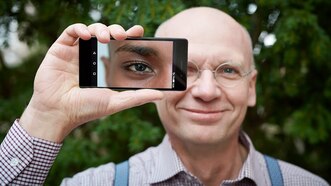 Learn more about Be My Eyes Learn more about Be My Eyes Be My Eyes is a free app that one can download to become a virtual volunteer for people who are visually impaired. Currently, there are almost 260,000 people with visual impairments registered with the app, and nearly 4 million volunteers who have downloaded it as well. The app allows a blind or visually impaired person to reach out with a simple press of a button. This then sends a message to volunteers, alerting them that someone from Be My Eyes ‘is calling’. The first person to click the message alert will answer the call and be able to provide assistance, be it with reading names on mail envelopes or finding the page for a recipe. The beauty of the app is that it allows the volunteers to only pick up calls that occur at a time that is convenient for them, and with the large number of volunteers, there is no worry about a call going unanswered. I immediately downloaded the app and waited for my first call, which eventually happened a month or so later. There were a few calls before this, but I was never quick enough to answer – someone always beat me to it! My first call was with a man who was looking for help figuring out where to type in a password. He expressed that he struggled with the number of passwords he had to type in for different sites, so I told him about the idea of online password keepers. He was thrilled to learn about this, and him and I spent a little while longer just chatting about life. He asked me what I did at school, and he told me about his jobs and travel when he was my age. He seemed so genuinely happy to just share stories and have a conversation with a complete stranger. After 15 minutes or so, he thanked me and ended the call. This was not my only experience like this: I was also able to answer another call a few weeks later (before anybody else did!) and I ended up enjoying some friendly small talk while helping a woman figure out recipes. This call coincided with an email about a challenge at Carleton – the One HEALtH Challenge run by the CHAIM Centre – that was seeking ideas for ways in which connection between younger and older generations could be created to help target and combat the impacts of isolation that both populations were suffering from as a result of the pandemic. At the time of the email, I was not able to participate in the Challenge, but it did spark an idea: what if we were to create an app like Be My Eyes whereby elderly residents and young volunteers could connect? 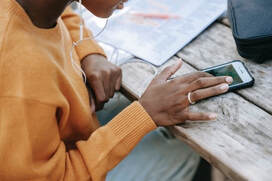 I thought about it more: Perhaps the users could set time limits if they preferred to know in advance of taking a call whether it would be 10 minutes or 30 minutes. Or maybe the app could be designed more as a place where volunteers and users could log in and be connected to others online, rather than having messages alert volunteers. The latter concept made me think of the way phone games (like ‘Words with Friends’ or ‘Draw Something’) are designed in such a way that the software will connect people in real-time, based on who is logged in. This way, people could log in when they had some downtime and wanted to volunteer. Notifications could even be used to let elderly users who are seeking some connection know there were volunteers looking to chat (maybe this would help alleviate any feelings of anxiety or shame that might prevent someone who is lonely from using the app to reach out). As well, the fact that there would likely be far more volunteers than users would prevent the app from becoming something that could be viewed as obligatory or stressful by the volunteers. An app would offer other benefits that could increase the likelihood of its use and its success: The software could be designed to keep the cameras off and create less pressure, or if a more personal connection were preferred, perhaps the app could have a sliding ‘blur’ whereby users could adjust a filter to retain some anonymity. Like Be My Eyes, the app could further ensure privacy by providing neither side with contact information, alleviating any worries with respect to personal safety for both the users and the volunteers. In my mind, this idea has potential. I think a smartphone app like this could allow people from younger and older generations from all over the world to connect, which would certainly make for some very interesting shared experiences and stories that could encourage more people to take part. While technology has led to an increase in disconnection between humans, I think it could be used as a tool to create social interactions that are exciting and novel, and expose people to others who are from different backgrounds, with different perspectives on life. Perhaps younger and older generations alike would discover that it is the differences between people that should be embraced and even celebrated, as these differences are what make human connection interesting and fulfilling. 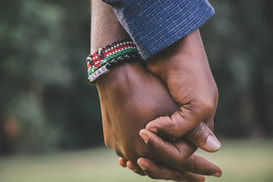 The CHAIM Centre recognizes that the month of February celebrates Black excellence and resilience. At the same time, we are aware that systemic racism remains a pervasive issue in our society, with serious implications for the health of Black Canadians. This month and every month, as a research centre whose goal is to advance health research and its application to health care accessibility across Canada, we stand in alliance with Black students, colleagues, and community members to bring about the fundamental changes needed for a just and equitable society. In recognition of Black History Month, our team has compiled a reading list of articles that we personally found compelling on the topic of Black health and wellness. Many (but not all) of these articles focus on a Canadian perspective. ‘It just weighs on your psyche’: Black Americans on mental health, trauma, and resilience By: Crystal Milner An article featuring photos and interviews of Black Americans and their experiences and perspectives surrounding COVID, police brutality, and most importantly resilience. Police Brutality in Canada: A Symptom of Structural Racism and Colonial Violence By: Krista Stelkia This article by the Yellowhead Institute discusses how police brutality against Black and Indigenous people is the result of structural racism in Canadian society and the roles that policy, data, and solidarity have to play in holding our systems accountable. Untangling racism: Stress reactions in response to variations of racism against Black Canadians By: Kimberly Matheson et al. This academic article considers various aspects of the racism (e.g., extent of ambiguity or violence) that is encountered by Black Canadians, and the implications for stress-related emotional reactions, such as distress or anger. These emotional reactions have implications for vulnerability or resilience to depressive symptoms. Beyond Allyship: Motivations for Advantaged Group Members to Engage in Action for Disadvantaged Groups By: Helena Radke et al. Why do Whites participate in the BLM movement? There are several motivations for such allied action, some of which are authentic, and some that give rise to greater tension. This article reviews the research to understand the actions of allies. Taking Black Pain Seriously By: Oluwafunmilayo Akinlade Centering on the issue of pain treatment, this article from the New England Journal of Medicine is compelling, readable, and effectively illustrates the connection between the history of medical racism and current healthcare outcomes for Black patients. The Impact of COVID-19 on Black Canadians By: The African-Canadian Civic Engagement Council and Innovative Research Group The data in this report paints a clear and urgent picture of the disproportionate impact that the pandemic is having on Black communities in Canada, examining both health and financial trends related to COVID-19. Black History Month: Food For Thought (It’s Not What You Think) By: Jessica DeGore This article discusses emancipation in the American south, traditionally ‘poor’ southern food and how freedom affects cuisine. It explores how Black people throughout history used food and simple ingredients to create staples that persist today. Stop Whitewashing Our National History By: Tayo Bero Published in summer 2020, this article explores how Canada's failure to reckon with its historical mistreatment of Black and Indigenous people prevents us from addressing the racism embedded in Canadian society. Reparations as a Public Health Priority: A Strategy for Ending Black–White Health Disparities By: Mary T Bassett and Sandro Galea This article discusses the roots of the Black-White health gap in America, how this impacts access to medical resources, and how reparations could be leveraged to address this major disparity. Let's Talk: Whiteness and Health Equity By: National Collaborating Centre for Determinants of Health Aimed at a public health audience, this publication explains how "the practices, policies and perspectives that create and enable the dominance of White people, norms and culture" impacts the health of all Canadians, and presents strategies for disrupting Whiteness at the individual, institutional, and systemic levels to increase health equity. Urban renewal has displaced Black communities in Canada in the past. Can getting involved early in the planning stop it from happening again? By: Donovan Vincent This article discusses the impact that current and historical gentrification has had on Black communities in Canada. A group of experts weigh in on strategies to mitigate its effects. More Resources: A free 30-day course on allyship with prompts and reflections to act and think in solidarity with Black women. |
Archives
March 2023
Categories
All
|

 RSS Feed
RSS Feed